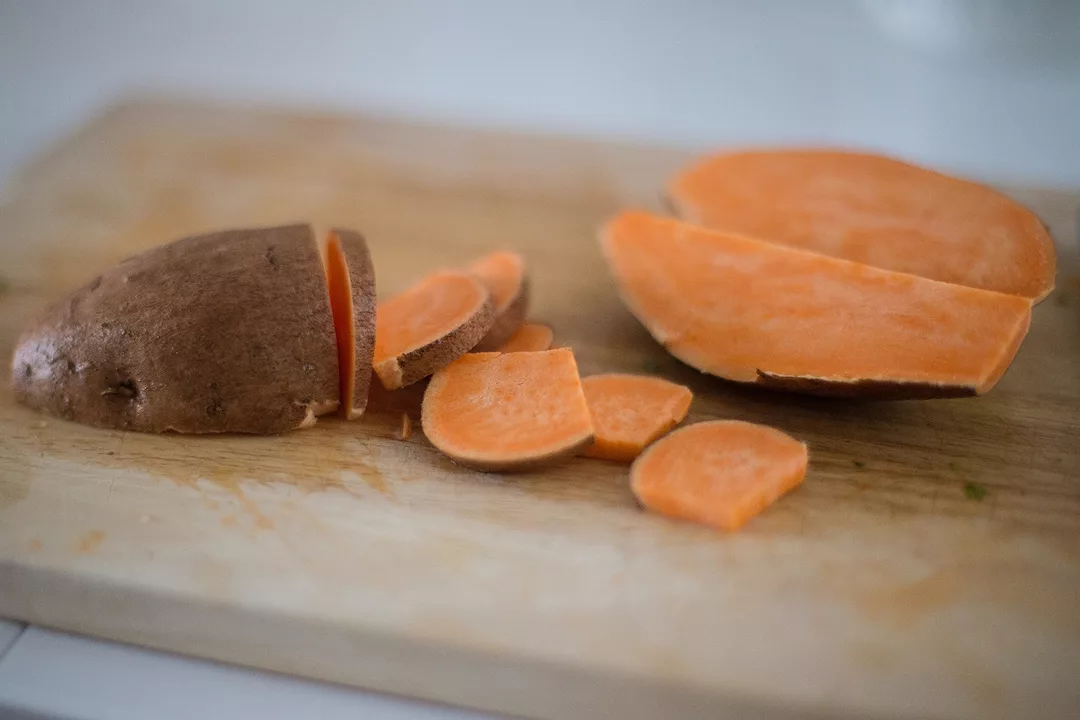
Home » Sweet potatoes or yam? Let’s unravel the myths
Sweet potatoes or yam? Let’s unravel the myths

November 14, 2019
By Marilou Shea
If you’re a foodie, you’re probably head down planning your Thanksgiving dinner in earnest right about now, though the ultimate foodie would have started in September when harvest was underway. And this foodie would have already taste-tested new recipes, twisted from the traditional ones, and scoured local stores to ensure the ingredients recommended by Ina Gartner, host of the Food Network’s “Barefoot Contessa,” were available.

This means it’s a good time to talk about the difference between sweet potatoes and yams. I’m here to help set the record straight, dispel the rumors and manage the myths.
Sweet potatoes are what we find most commonly in the U.S. produce section of our grocery stores. Like Visa, they’re everywhere! They hail from the tropical Americas and can have a pretty red or raspberry skin and orange flesh, a purple skin with purple flesh, or pale ivory skin with pale flesh. Sweet potatoes, like their distant cousin, the russet, are tubers because their edible parts are grown down under. They’re typically harvested during the fall and the optimal time to eat them is of course fall and as a star attraction for your Thanksgiving feast.
That pretty yam tuber you gushed over in the grocery store aisles, tucked into a bag and bought without nary a thought as to its genuine heritage was, in fact, most likely a sweet potato. Mind you, the U.S. often has had to play catch up and backtrack either from its culinary denial or irrefutable gastric faux pas, and this, dear friends, happens to be one of those occasions. Sweet potatoes have so often been deeply confused as a yam because of vernacular tendencies that we have literally and figuratively bought into the myth that a yam is a sweet potato and vice versa.
There’s the garnet and the jewel sweet potato varieties which look so similar that you’d have to do a DNA test to decipher the difference. They typically are 6 inches to 8 inches long and about 3 inches thick. They are smooth, naked and rarely hairy like a yam. They have become the darling for health aficionados because they’re offered as a healthy alternative in the fast-casual dining sector with growing popularity. They come from the genus Ipomoea and are closely related to the noxious, but lovely vine, the morning glory. Garnet sweet potatoes are moist, sweet tasting and starchy boasting a vibrant orange flesh.
White, sweet potatoes are often called Jersey sweet potatoes. They are less sweet than their garnet brethren, less soft and more fibrous when cooked. Some claim they are more like a russet in taste.
The purple sweet potato that often have strange crooks to their shape are called Stokes Purple. Unlike other purple vegetables, these beauties maintain their exotic purple coloring and don’t leech out while cooking. The other added benefit is they are the sweetest of the sweet potato in flavor. I hope you’re taking notes.
Most Americans have probably not seen a real yam much less tasted one—unless you’ve lived or traveled in Asia or Africa where they set down roots. To add to the confusion, yams have a different name across many countries and many languages. Japanese yam looks like a taupe 8-inch bullet and can grow to 100 pounds with a bark-like skin. They’re kind of a hairy beast with root tendrils and white flesh that’s sometimes described as crisp but slimy like okra. They are more starchy and dry than the sweet potato all around and hail from the genus Dioscorea, growing from a vine.
The confusion can be traced back to the 18th century when Africans were brought to America and yearned for yams so much so that they adopted the plentiful sweet potato as the nearest, best thing to a yam. Fast forward to the mid-1930s when branding became a thing among Louisiana growers. They decided to call their orange sweet potatoes “yams” to differentiate them from their competitors’ yellow ones and in their minds the lesser of the two varietals. Today, it’s actually illegal to market sweet potatoes exclusively as yams. Somewhere between the photo on the label and the nutritional facts mention must be made that they’re actually sweet potatoes, not true yams,
Celebrity chef Rachael Ray has said that sweet potatoes are the most nutrient-dense vegetable you can buy in the produce section. They are the penultimate vegetable ounce for ounce this side of the deli aisle because of their long shelf life, great taste, nutrient-rich properties and subsequent health benefits. I might add their appeal is also their low cost and all the dreamy, steamy, creamy ways to cook with them. Enjoy your Thanksgiving feast featuring one of the many and varied…sweet potatoes our country has to offer. What’s not to love?
Food Love columnist Marilou Shea is an educator by day and is the founder of Food Truck Fridays. Read her blog at foodlove.net.
Local News
KEYWORDS november 2019





